Indian student arrivals to U.S. fall 44 percent, biggest drop since pandemic: Report
Indian students account for nearly one-third of all international students in the U.S., and the decline signals deepening challenges for aspirants.
 Representative image / Photo by Priscilla Du Preez
Representative image / Photo by Priscilla Du Preez
The number of Indian students arriving in the United States in August fell by 44 percent compared with last year, contributing to a 19 percent decline in overall international student arrivals—the sharpest drop since the pandemic.
According to preliminary data from the U.S. Department of Commerce’s Trade.gov,, this marks the steepest decline on record outside the pandemic years. The fall is being attributed to a combination of visa delays, new travel restrictions on 19 countries, and increased scrutiny of student visa applicants under the Trump administration.
Also Read: Trump administration has revoked 80,000 non-immigrant visas, US official says
Nearly one in three international students in the U.S. are from India. The decline in arrivals, following last year’s downturn, underscores the mounting difficulties Indian students face in securing timely visas and reaching U.S. campuses.
Students from Asia—who make up more than 70 percent of all international students in the U.S.—recorded a 24 percent decline in arrivals this August, while students from Africa saw a 32 percent drop. Ghana and Nigeria reported that nearly half their students were unable to travel, and arrivals from China declined by about 12 percent.
The Commerce Department data, which includes both new and returning students, points to a broader slowdown in higher education mobility. A separate federal database also showed that the overall increase in international students this fall was 23 percent smaller than the same period last year.
The decline coincides with prolonged delays in visa interviews—including a three-week suspension in May—and months-long appointment backlogs that prevented many students from arriving in time for the fall semester.
In addition, the U.S. government imposed travel bans on several countries and introduced new rules requiring visa applicants to make their social media profiles public for what it described as “comprehensive vetting.”
NAFSA: Association of International Educators, a nonprofit organization, projected a 30 to 40 percent decline in new international student enrollment this fall, translating into an estimated $7 billion loss to the U.S. economy. Smaller arts institutions, Christian colleges, and flagship state universities are already reporting sharp downturns in international admissions.
Ohio State University reported a 38 percent decline in new international students, while Indiana University saw a 30 percent drop across campuses. Universities such as the University of Central Missouri and DePaul University have reported losses of up to 50 to 60 percent in new international graduate students, citing visa difficulties and waning interest in studying in the U.S.
The impact is being felt most acutely in STEM graduate programs, where international students make up over 80 percent of enrollment. Many teaching assistants and researchers in university laboratories are foreign nationals, and the slowdown could impede scientific output in several departments.
Nearly three-quarters of foreign doctorate recipients in science and engineering stay to work in the U.S., and over 40 percent of all doctorate-level scientists and engineers in the country were born abroad.
Experts warn the current drop in student arrivals may have long-term implications for research, innovation, and the country’s scientific workforce.
ADVERTISEMENT
ADVERTISEMENT
E Paper
Video



1759953093.png) Staff Reporter
Staff Reporter









.jpg)

Comments
Start the conversation
Become a member of New India Abroad to start commenting.
Sign Up Now
Already have an account? Login